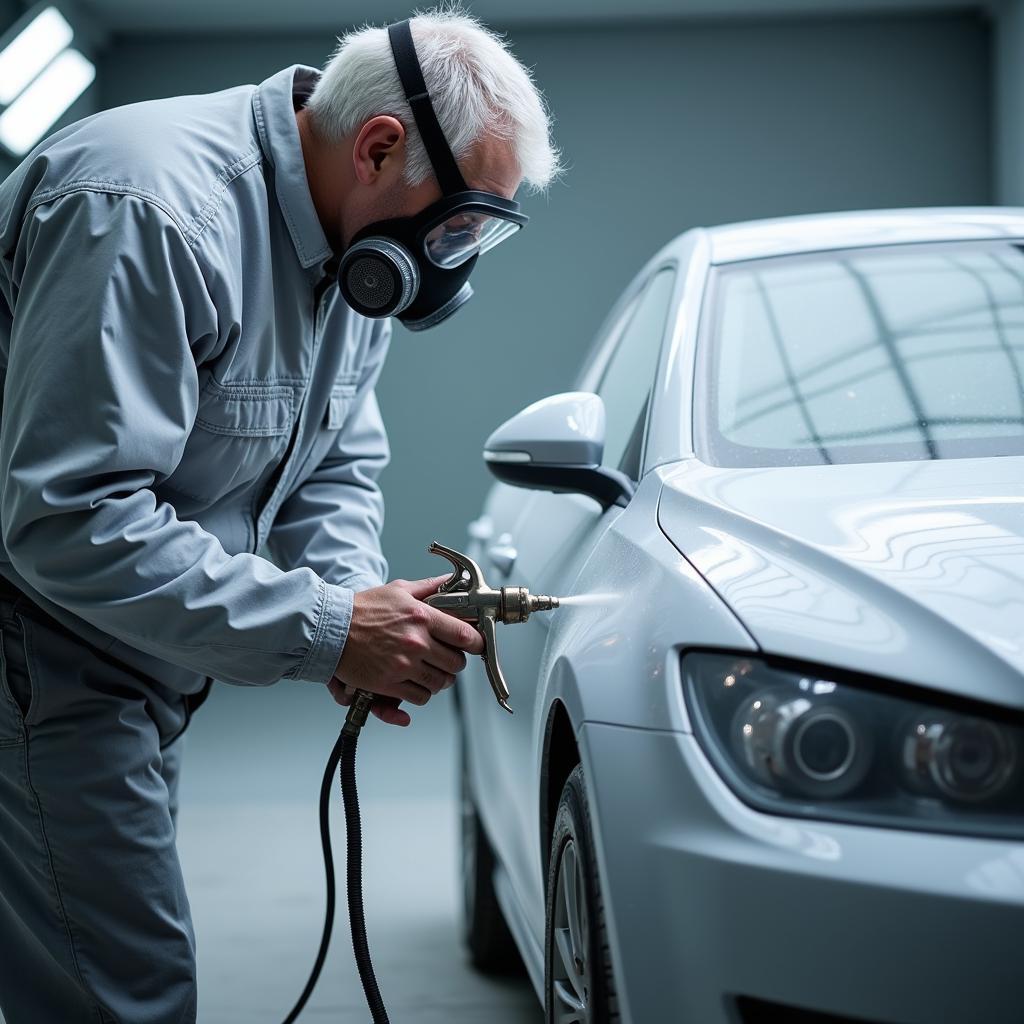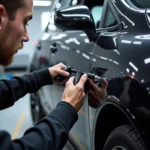Car body repair paints and fillers are essential components of any restoration project, ensuring a smooth, flawless finish. This guide will delve into the nuances of these materials, offering expert advice for both DIY enthusiasts and professionals. We’ll explore the different types of paints and fillers available, their specific applications, and best practices for achieving professional-grade results. Let’s dive in!
Understanding Car Body Fillers
Car body fillers, also known as putties or glazing putties, are used to repair dents, scratches, and other imperfections on car panels. They provide a smooth base for the paint, ensuring a professional-looking finish. Choosing the right filler is crucial, as different formulations are designed for specific applications and materials.
Types of Car Body Fillers
Several types of car body fillers are available on the market, each with its own unique properties:
- Lightweight Fillers: Ideal for minor imperfections and thin metal sheets. They are easy to sand and feather, providing a smooth surface for priming and painting.
- Heavy-Duty Fillers: Designed for larger dents and deeper scratches. They offer excellent adhesion and durability, making them suitable for more extensive repairs.
- Fiberglass Fillers: Reinforced with fiberglass strands for added strength and resistance to cracking. Often used in areas prone to stress or vibration.
- Lead-Free Fillers: An environmentally friendly alternative to traditional lead-based fillers. These fillers offer similar performance characteristics without the harmful effects of lead.
car body repair materials offer a wide range of fillers for various applications.
Choosing the Right Car Body Repair Paint
Once the filler has cured and been sanded smooth, it’s time to apply the paint. The correct paint not only enhances the vehicle’s appearance but also protects the underlying metal from corrosion.
Types of Car Body Repair Paints
- Acrylic Lacquer: A fast-drying paint that provides a high-gloss finish. It’s relatively easy to apply, but less durable than other options.
- Acrylic Enamel: A durable and chip-resistant paint that offers excellent color retention. It’s a popular choice for both DIY and professional repairs.
- Urethane: A high-quality paint that provides superior durability and resistance to chemicals and UV rays. It requires specialized equipment and expertise for application.
Achieving a Professional Finish with Car Body Repair Paints and Fillers
Achieving a flawless finish requires careful preparation and attention to detail. Here’s a step-by-step guide:
- Clean the Damaged Area: Thoroughly clean the area to be repaired to remove dirt, grease, and rust.
- Apply the Filler: Apply the filler in thin, even coats, allowing each coat to dry before applying the next.
- Sand the Filler: Once the filler has cured, sand it smooth using progressively finer grit sandpaper.
- Prime the Area: Apply a primer to promote adhesion and ensure a uniform paint finish.
- Apply the Paint: Apply the paint in thin, even coats, allowing each coat to dry before applying the next.
- Apply a Clear Coat (Optional): A clear coat adds an extra layer of protection and enhances the gloss of the paint.
“Proper surface preparation is the key to a successful car body repair. Rushing this stage will compromise the final result,” says John Miller, an experienced automotive refinisher.
car body repaire supplies nottingham can help you find all the necessary supplies for your car body repair project.
Common Car Body Repair Paint and Filler Issues
- Cracking: This can be caused by improper mixing of the filler, applying the filler to a flexible surface, or using the wrong type of filler.
- Blistering: This can be caused by moisture trapped beneath the paint or filler.
- Peeling: This can be caused by poor adhesion between the paint, primer, or filler and the underlying surface.
“Understanding the common pitfalls can help you avoid costly mistakes and achieve a professional-looking repair,” adds Miller.
Conclusion
Car body repair paints and fillers are essential for restoring a vehicle’s appearance and protecting its structural integrity. By understanding the different types of materials available and following proper application techniques, you can achieve professional-grade results. For sourcing high-quality materials, consider exploring car body repair supplies uk. Remember, patience and attention to detail are crucial for achieving a flawless finish. Car body repair paints and fillers, when used correctly, can transform a damaged vehicle back to its former glory.
FAQ
- What is the best type of filler for plastic bumpers?
- How long should I wait for the filler to dry before sanding?
- Can I apply car body filler over rust?
- What type of paint is best for beginners?
- How can I prevent paint runs and sags?
- What is the difference between single-stage and two-stage paint?
- How do I match the paint color to my car?
Common Scenarios and Questions
- Scenario: Deep scratch on a metal panel. Question: What type of filler and paint should I use?
- Scenario: Minor dent on a plastic bumper. Question: Can I use body filler on plastic?
- Scenario: Faded paint on the hood. Question: Can I just repaint the hood, or do I need to repaint the entire car?
Further Exploration
For information on specific car body repairs, check out car body repairs malvern and car body repairs in ringwood.
Need assistance with car body repair paints and fillers? Contact us via WhatsApp: +1(641)206-8880 or Email: [email protected]. Our 24/7 customer support team is ready to help.



